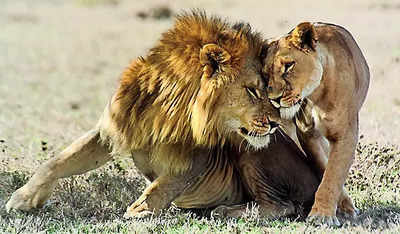[ad_1]

On a dark night in Feb, two male lions stood in the shallows of the Kazinga Channel in Queen Elizabeth National Park, in Uganda, and looked across the water. Nearly a mile away was the shore on the other side. Hippos and 16-foot crocodiles inhabit the channel, which can be 20 feet deep in places. Barely 12 hours earlier, the two males had lost a battle for territory and were lucky to still be alive.Remaining on this side of the channel was dangerous, and they could probably hear the roars of female lions in the distance.
As with many cat species, lions don’t like to swim. And one of the lions, known as Jacob by researchers, has only three legs. He lost a limb in a poacher’s trap in 2020. But neither Jacob nor his brother, Tibu, were deterred. The two big cats set out for what the researchers call the longest-recorded swim ever taken by lions. The lions struggled on their first three tries to cross. During the second attempt, the drone that was tracking them picked up a large thermal signature that may have been a crocodile or a hippo in pursuit; the two male lions split into a Y formation before hurrying back to shore. Less than an hour after their first attempt, the two set out again for a third time. The path seemed clear and they kept going until they crossed the channel. “It was pretty dramatic,” said Alexander Braczkowski, a conservation biologist who has been studying the lions since 2017.
Lions have been observed swimming in Okavango Delta in Botswana, but rarely farther than 150 feet. In 2012, a lion swam around 330 feet across the Zambezi River, from Zimbabwe to Zambia. In Nov 2023, a young male lion swam across the Rufiji River in Tanzania, crossing as much as 985 feet of water.
But Braczkowski estimated that the two lions swam nearly a full mile. Why would lions make such a dangerous crossing? “Sex,” said Craig Packer, who ran the Serengeti Lion Project for 35 years. “If there’s nobody to mate with, what are you doing?” According to Braczkowski, the park’s lion population has fallen to around 40 today from 71 lions in 2018, with at least 17 lions, mostly females, poisoned by nearby residents aiming to protect their livestock. Males outnumber females 2 to 1. “These males and these swimming events are a symptom of this problem.”
[ad_2]
Source link







